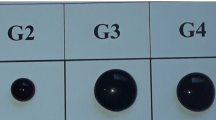A laboratory technique was developed for obtaining an ultra-low-background hybrid material based on organic glass — polymethyl methacrylate (PMMA). 157Gd nuclei are used as an efficient absorber of thermal neutrons in the hybrid material. A uniform distribution of gadolinium in the PMMAmatrix is achieved by introducing the gadolinium in the form of a coordination compound — gadolinium acetylacetonate — into the hybrid material. A uniform gadolinium distribution was achieved in a 5 cm thick matrix of hybrid material with gadolinium mass content from 1.0 to 1.5%. It is shown that at 298 K the mechanical characteristics of the hybrid material samples coincide with nominally pure PMMA, but at 77 K the hybrid material is inferior to pure PMMA within admissible requirements.





Similar content being viewed by others
References
M. P. Zykova, I. V. Stepanova, A. S. Chepurnov, and I. Kh. Avetisov, “Technology of ultra-low-background gadolinium-based preparations. Part 1. Impurity composition investigations of gadolinium-containing preparations for the determination of promising raw materials,” Tsvetn. Met., No. 11, 35 – 41 (2020).
P. Agnes, L. Agostino, I. F. M. Albuquerque, et al., “The VETO system of the DarkSide-50 experiment,” J. Instrumentation, 11, 03016 (2016).
I. K. Kikoin (ed.), Tables of Physical Quantities: Reference [in Russian], Atomizdat, Moscow (1976).
D. M. Poehlmann, D. Barker, H. Chagani, et al., “Characterization of gadolinium-loaded plastic scintillator for use as a neutron veto,” arXiv:1812.11267v1[physics.ins-det] [Electronic resource] (2018). URL: https://arxiv.org/abs/1812.11267v1
J. Dumazert, R. Coulon, Q. Lecomte, et al., “Gadolinium for neutron detection in current nuclear instrumentation research: A review,” Nuclear Inst. Methods Phys. Res. A, 882, 53 – 68 (2018).
K. Hagiwara, T. Yano, T. Tanaka, et al., “Gamma-ray spectrum from thermal neutron capture on gadolinium-157,” Progr. Theor. Exp. Phys., No. 2, 023D01 (2019).
D. S. Akerib, C. W. Akerlof, S. K. Alsum, et al., “Projected WIMPsensitivity of the LUX-ZEPLIN (LZ) dark matter experiment [Electronic resource], in: Astrophysics. Instrumentation and Methods for Astrophysics, Cornell University (2019). URL: https://arxiv.org/abs/1802.06039v2
E. Pruszkowski and P. E. Life, Total Quant Analysis of Teas and Wines by ICP-MS, Perkin Elmer Life and Analytical Sciences, Field Application Report, ICP Mass Spectrometry, USA(2004).
D. J. Carbaugh, J. T.Wright, R. Parthib, and F. Rahman, “Photolithography with polymethyl methacrylate (PMMA),” Semicond. Sci. Technol., 31(2), 025010 (2016).
D.W. Krevelen and K. Nijenhuis, Properties of Polymers: Their Correlation with Chemical Structure; Their Numerical Estimation and Prediction from Additive Group Contributions, Elsevier (2009).
G. Holden, “Elastomers, thermoplastic,” in: Encyclopedia of Polymer Science and Technology, Wiley & Sons (2004), Vol. 12, pp. 63 – 88.
Polymethylmethacrylate (PMMA, Acrylic). URL: https://www. makeitfrom.com_material-properties_Polymethylmethacrylate- PMMA-Acrylic (Date of access: 08.07.2020).
E. A. Bratsykhin and E. S. Shulgina, Technology of Plastic Masses [in Russian], Khimiya, Leningrad (1982).
K. Binnemans, “Rare-earth beta-diketonates,” Handbook on the Physics and Chemistry of Rare Earths, 35(5), 107 – 272 (2005).
V. I. Boiko, V. A. Vlasov, and I. I. Zherin, et al., Thorium in the Nuclear Fuel Cycle [in Russian], Izd. Dom Ruda i Metally, Moscow (2006).
I. I. Zherin and G. N. Amelina, Chemistry of Thorium, Uranium, Plutonium [in Russian], Izd. TPU, Tomsk (2010).
V. A. Rabinovich and Z. Ya. Khavin, Brief Chemical Handbook [in Russian], Khimiya, Leningrad (1991).
J. Katz, G. Seaborg, and L. Lorss (eds.), Chemistry of Actinides [Russian translation], Mir, Moscow (1999), Vol. 3.
E. Pretsch, F. Bühlmann, and K. Affolter, Spectral Data Tables: Structure Determination of Organic Compounds [Russian translation], Binom. Knowledge Laboratory, Mir, Moscow (2006), pp. 251 – 318.
Author information
Authors and Affiliations
Corresponding author
Additional information
Translated from Steklo i Keramika, No. 3, pp. 3 – 10, March, 2021.
Rights and permissions
About this article
Cite this article
Zykova, M.P., Khomyakov, A.V., Grishechkin, M.B. et al. Gadolinium-Based Hybrid Ultra-Low-Background Material for Protecting the Darkside20k Dark Matter Detector from Background Neutrons. Glass Ceram 78, 91–96 (2021). https://doi.org/10.1007/s10717-021-00354-4
Published:
Issue Date:
DOI: https://doi.org/10.1007/s10717-021-00354-4




